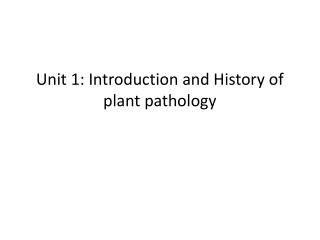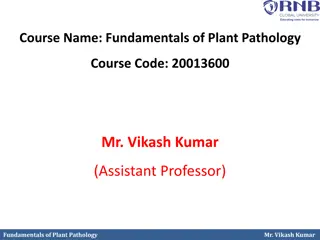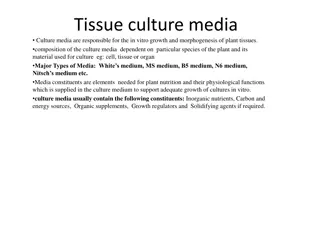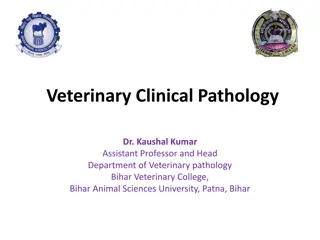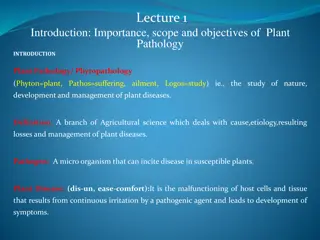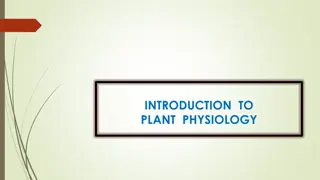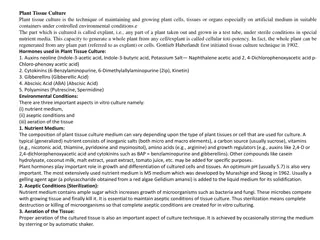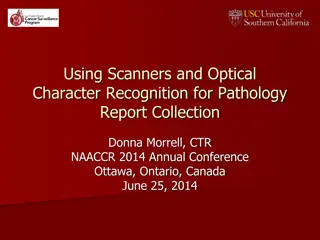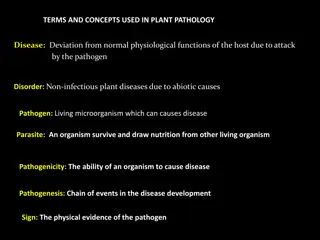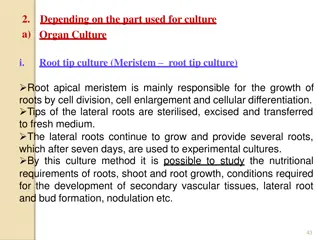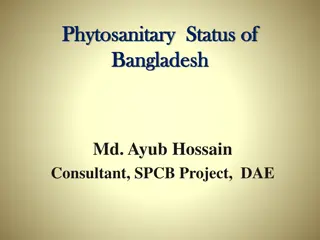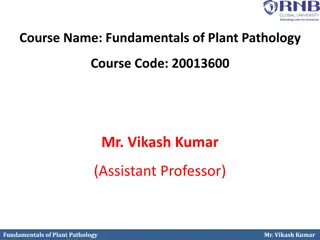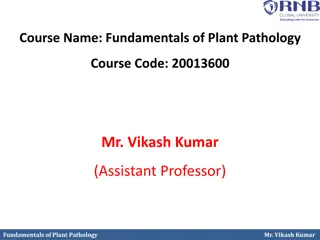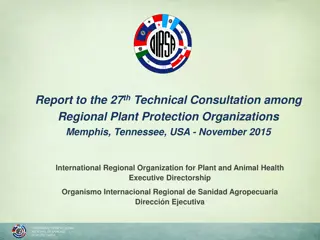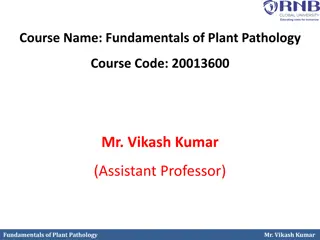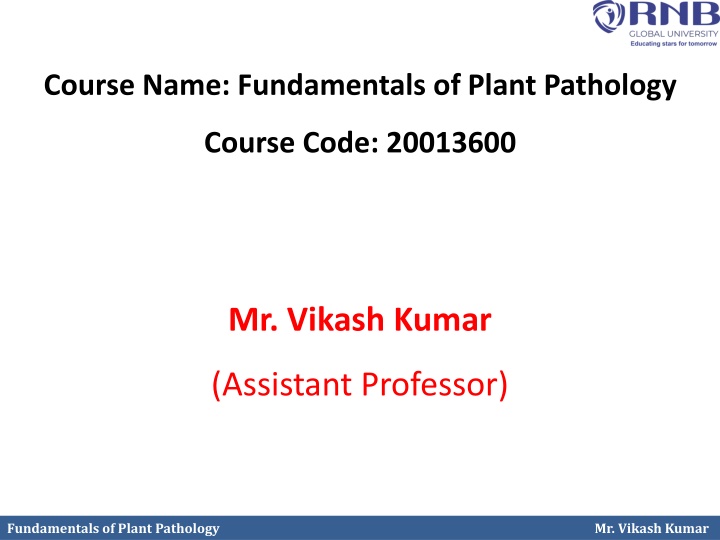
Fundamentals of Plant Pathology with Mr. Vikash Kumar
Explore the essentials of plant pathology with Mr. Vikash Kumar, covering diseases, pathogens, management strategies, and key concepts in plant pathology. Gain insights into disease identification, pathogen nature, and disease management techniques.
Download Presentation

Please find below an Image/Link to download the presentation.
The content on the website is provided AS IS for your information and personal use only. It may not be sold, licensed, or shared on other websites without obtaining consent from the author. If you encounter any issues during the download, it is possible that the publisher has removed the file from their server.
You are allowed to download the files provided on this website for personal or commercial use, subject to the condition that they are used lawfully. All files are the property of their respective owners.
The content on the website is provided AS IS for your information and personal use only. It may not be sold, licensed, or shared on other websites without obtaining consent from the author.
E N D
Presentation Transcript
Course Name: Fundamentals of Plant Pathology Course Code: 20013600 Mr. Vikash Kumar (Assistant Professor) Fundamentals of Plant Pathology Mr. Vikash Kumar
Course Objectives 1: Name and identify different Diseases, nature of pathogens and different strategies for management of plant diseases. 2: Outline concepts, nomenclature, classification and characters of pathogens 3: Apply different principles and methods for plant disease management. 4: Take a part in identification of diseases and marketing of relevant pesticides. 5: Conclude methods to diagnose and manage a wide range of plant diseases. Fundamentals of Plant Pathology Mr. Vikash Kumar
Terms and Concepts in Plant Pathology Fundamentals of Plant Pathology Mr. Vikash Kumar
Disease: According to Horsfall and Diamond (1959), disease may be defined as a malfunctioning process that is caused by continuous irritation by a pathogen . Disorder: Non-infectious plant diseases due to abiotic causes such as adverse soil and environmental conditions are termed disorders. Pathogen: It is the agent responsible for inciting pathos i.e. ailment or damage. Disease Incidence: the number of plants affected by a disease within a population. E.g. soil borne diseases, nematodes Disease Severity: the measure of damage done by a disease. OR Amount of disease present in a population. E.g. Leaf, stem, seed diseases Hypha: a single tubular thread-like filament of a fungal mycelium. The hypha is the basic structural unit of a fungus. Mycelium: a mass of hyphae that forms the body (thallus) of a fungus called mycelium. Fundamentals of Plant Pathology Mr. Vikash Kumar
Spore: a specialized reproductive body in fungi (and some other organisms), containing one or more cells, capable of developing into an adult. Biotroph: an organism that can live and reproduce only on another living organism. A biotroph is completely dependent on the host organism as a source of nutrients, i.e. it is an obligate parasite. Necrotroph: an organism (parasite) that causes the death of host tissues as it grows through them, obtaining its energy from the dead cells. Saprophyte: an organism that obtains nourishment from non-living organic matter (usually dead and decaying plant or animal matter) by absorbing soluble organic compounds. Fundamentals of Plant Pathology Mr. Vikash Kumar
Pathogenicity: The capacity of a pathogen to cause disease. Pathogenesis: is the chain of events that lead to development of disease in the host (or) sequence of progress in disease development from the initial contact between the pathogen and its host to the completion of the syndrome. Sign: The pathogen or its parts or products seen on a host plant./ Physical proof of pathogen. Symptom: The external or internal reactions or alterations of a plant as a result of a disease. Syndrome: The set of varying symptoms characterizing a disease are collectively called a syndrome. OR The series of symptoms of a disease collectively known as syndrome. Fundamentals of Plant Pathology Mr. Vikash Kumar
Virulence: The degree of pathogenicity of a given pathogen. Virulent: Capable of causing a severe disease; strongly pathogenic. Avirulent (non-virulent): Non-pathogenic or lacking virulence. Infection: The establishment of a parasite within a host plant. Latent Infection : where the host is infected with a pathogen but does not show any symptoms. Fundamentals of Plant Pathology Mr. Vikash Kumar
Infectious disease: A disease that is caused by a pathogen which can spread or transfer from a diseased to a healthy plant. Non-infectious disease: A disease that is caused by an abiotic agent, that is, by an environmental factor, not by a pathogen. Inoculum: The pathogen or its parts that can cause infection. That portion of individual pathogens that are brought into contact with the host. Inoculum potential: Which consists of the number of propagules and their capacity to cause infection. Inoculation: The arrival or transfer of a pathogen onto a host. Fundamentals of Plant Pathology Mr. Vikash Kumar
Transmission: The transfer or spread of a pathogen from one plant to another. Isolation: The separation of a pathogen from its host and its culture on a nutrient medium. Penetration: The initial invasion of a host by a pathogen. Primary infection: The first infection of a plant by the overwintering or oversummering pathogen. Primary inoculum: The overwintering or oversummering pathogen, or its spores that cause primary infection. Secondary infection: Any infection caused by inoculum produced as a result of a primary or a subsequent infection. OR An infection caused by secondary inoculum. Secondary inoculum: Inoculum produced by infections that took place during the same growing season. Fundamentals of Plant Pathology Mr. Vikash Kumar
Immune: Cannot be infected by a given pathogen. Resistant:Possessing qualities that hinder the development of a given pathogen. OR Infected little or not at all. Susceptible: vulnerable or prone to damage or infection by pathogens; non- immune. Tolerance:The ability of a plant to sustain the effects of a disease without dying or suffering serious injury or crop loss. Fundamentals of Plant Pathology Mr. Vikash Kumar
Bacteriology: The study of bacteria is called bacteriology. OR It is the science which deals with the study of bacteria is known as bacteriology. Mycology: The study of fungi is called mycology. OR It is the science which deals with the study of fungi is known as mycology. Nematology:It is the science which deals with the study of nematodes. Virology: It is the science which deals with the study of viruses. Bacteriology: It is the science which deals with the study of bacteria. Fundamentals of Plant Pathology Mr. Vikash Kumar
Disinfectant: A physical or chemical agent that frees a plant, organ or tissue from infection. Fungicide: Chemicals used to kill fungi OR A compound toxic to fungi. Nematicides: A chemical compound that kills nematodes. Bactericide:A chemical compound that kills bacteria. Fundamentals of Plant Pathology Mr. Vikash Kumar
Eradication: the control of plant disease by eliminating the pathogen after it is established or by eliminating all of the plants that carry the pathogen. Exclusion: a method of disease prevention in which the pathogen or infected plant material is excluded from crop production areas. See quarantine. Quarantine: legal restriction of the transport of plants and/or plant parts in order to prevent the spread of pests and pathogens. Fundamentals of Plant Pathology Mr. Vikash Kumar
Systemic: (disease) pertaining to a disease in which the pathogen spreads generally throughout the plant OR The growth of pathogen from the point of entry to varying extents without showing adverse effect on tissues through which it passes.; (chemical) pertaining to a chemical absorbed into the plant through root or foliage and transported internally throughout the plant. Systemic fungicide: a chemical agent that spreads internally through the plant and eradicates established fungal infections. Vector: any living organism (e.g., insect, mite, bird, nematode, parasitic plant, human, etc.) that transmits a pathogen from an infected organism to an uninfected one. Virus: a submicroscopic, non-cellular structure consisting of a core of infectious nucleic acid (either RNA or DNA) within a protein coat. Fundamentals of Plant Pathology Mr. Vikash Kumar
Necrosis: Death of tissue, cells or organ is known as necrosis. Phyllody: Floral part converted into leafy structure is called as phyllody. Hypertrophy: Excessive growth of host tissues due to increase in size of affected organs or cells of a particular tissues. Hyperplasia: It is the abnormal increase in the size of a plant organ due to increase in number of cells of which the organ is composed. Fundamentals of Plant Pathology Mr. Vikash Kumar
Disease cycle: The chain of events as the transmission of pathogen, attack on the host, infection, invasion of tissues and development and reproduction of pathogen on the host to completing the process of pathogenesis. Antagonism: Injury, killing or inhibition of the growth of one species of microorganism to another microorganism. Antagonists: An organism having the capacity or ability to inhibit the growth or interfere with the activity of another microorganism. Antibiosis: Inhibition or destruction of one microorganism by a metabolic products of another microorganism. Competition: The ability of one organism to utilize a substrate more efficiently than another microorganism. Hyper parasitism: The parasitism of a parasite by another parasite. (Rhizoctonia solani on Pythium spp., Fusarium maxima on Rust fungi). Fundamentals of Plant Pathology Mr. Vikash Kumar
Disease symptoms Blight: sudden death of twigs, foliage, and/or flowers. Blotch: large and irregular-shaped spots or blots on leaves, shoots, and stems. Canker: dead places on bark and cortex of twigs or stems; often discoloured and raised or sunken. Fundamentals of Plant Pathology Mr. Vikash Kumar
Chlorosis: yellowing of normally green tissue due to reduced chlorophyll content, such tissue is known as chlorotic tissue. Damping-off: destruction of seeds in the soil, or seedlings near the soil line, resulting in reduced stand, or the seedling falling over on the ground. Fundamentals of Plant Pathology Mr. Vikash Kumar
Decline: progressive, gradual weakening and death of a plant or population of plants. Dieback: progressive, gradual weakening and death of individual branches of a plant, often leading to decline. Fundamentals of Plant Pathology Mr. Vikash Kumar
Galls: abnormal, localized swellings or tumors, on leaf, stem or root tissue. Gum: complex of sugary substances formed by cells in reaction to wounding or infection. gummosis: production of gum by or in a plant tissue. Inoculum: amount of pathogen available for infection. Fundamentals of Plant Pathology Mr. Vikash Kumar
Leaf spot: a self-limiting lesion on a leaf Lesion: a localized area of discolored, diseased tissue Mildew: a plant disease in which the pathogen is seen as a growth on the surface of the host; e.g., downy mildew, powdery mildew, caused by very different fungi, but both having the name Mildew. Fundamentals of Plant Pathology Mr. Vikash Kumar
Mosaic: symptom of certain viral diseases of plants characterized by intermingling patches of normal green and light green or yellowish colors. Mycelium: masses of fungal threads (hyphae) which compose the vegetative body of the fungus Necrosis: death of tissue Ooze: a mass of bacterial cells usually embedded in a slimy matrix appearing on the diseased plant surface, often as a droplet; or, a flux, a viscid mass of juices composed of host and parasite substances occasionally found exuding from a diseased plant. Fundamentals of Plant Pathology Mr. Vikash Kumar
Pycnidia: minute, usually globose and black, fungal asexual fruiting structures formed on plant surfaces Rot: the softening, discoloration, and disintegration of succulent plant tissue as the result of fungal or bacterial infection Scab: a roughened crust-like diseased area on the surface of a plant organ; a disease in which such areas form Fundamentals of Plant Pathology Mr. Vikash Kumar
Sclerotia: tough structures produced by fungi for long-term survival. Vein banding: retention of bands of green tissue along the veins while the tissue between veins has become chlorotic. Vein clearing: destruction of chlorophyll adjacent or in the vein tissue as a result of infection by a virus or other pathogen Fundamentals of Plant Pathology Mr. Vikash Kumar
Wilt: loss of rigidity and drooping of plant parts generally caused by insufficient water and nutrients in the plant due to blockage of root system. Witches' broom: broom-like growth or massed proliferation caused by the dense clustering of branches in woody plants. Fundamentals of Plant Pathology Mr. Vikash Kumar
Thank You Fundamentals of Plant Pathology Mr. Vikash Kumar

